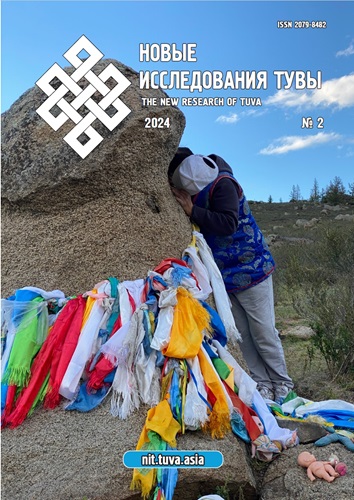The yurt and its details in Tuvan riddles
DOI:
https://doi.org/10.25178/nit.2024.2.8Keywords:
riddle; Tuvan folklore; Tuvan language; worldview; cultural code; archetypical opposition; yurtAbstract
The article analyzes the linguistic and cultural features of Tuvan riddles related to felt yurts. The study focuses on Tuvan riddles related to artifacts in their enigmatic function (objects of reality encoded in riddles). The source for the study was a collection of Tuvan riddles compiled by G. N. Kurbatsky, from which 297 riddles were selected using continuous sampling method. Ratings of the thematic groups and frequency of riddles have been compiled. Based on the findings, the mysteries of the yurt occupy prominent positions in this context. It has been demonstrated that the yurt and its various parts are encoded through a series of riddles, which are embedded within the archetypal oppositions of “top — bottom”, “outside — inside”, “open — closed”, “moving — stationary”, and “animate — inanimate”. At the same time, anthropomorphic, zoomorphic, and biomorphic cultural codes are often used to metaphorically describe artifacts, in other words, objects are described through the metaphorization of natural phenomena.
References
Bochina, T. G. (2023) The proverb is said for centuries: selected works on Russian paremiology. Kazan', Izd-vo Kazanskogo un-ta. 286 p. (In Russ.).
Bredis, M. A., Dimoglo, M. S. and Lomakina, O. V. (2020) Paremias in Modern Linguistics: Approaches to Study, Text-Forming and Linguocultural Potential. RUDN Journal of Language Studies, Semiotics and Semantics, vol. 11, no. 2, pp. 265–284. (In Russ.). DOI: https://doi.org/10.22363/2313-2299-2020-11-2-265-284
Bredis, M. A. and Ivanov, E. E. (2022) Linguoculturological commentary in polylingual dictionaries of proverbs. Russian Journal of Lexicography, no. 26, pp. 5–29. (In Russ.). DOI: https://doi.org/10.17223/22274200/26/1
Vorob'ev, V. V., Fatkullina, F. G. and Kuzhuget, Sh. Yu. (2023) Numerical code of Tuvan linguistic culture in proverbs (as contrasted to a number of Turkic and Mongolian languages of the peoples of Russia)]. New Research of Tuva, no. 4, pp. 276–293 (In Russ.). DOI: https://doi.org/10.25178/nit.2023.4.11
Kenin-Lopsan, M. B. (2006) Traditional Tuvan culture. Kyzyl, Tuvinskoe knizhnoe izdatel'stvo. 232 p. (In Russ.).
Ivanov, E. E. (2022) Absurd and Paradoxical Proverbs in Tuvan: Ontological and Logical Aspects of the Categorization of Proverbial Semantics. Oriental Studies, vol. 15, no. 6, pp. 1373–1388. (In Russ.). DOI: https://doi.org/10.22162/2619-0990-2022-64-6-1373-1388
Ivanov, E. E. (2023) Categorization of Attitude to Reality in Paremiological Units. RUDN Journal of Language Studies, Semiotics and Semantics, vol. 14, no. 4, pp. 1154–1177. (In Russ,) DOI: https://doi.org/10.22363/2313-2299-2023-14-4-1154-1177
Ivanov, E. E., Lomakina, O. V. and Petrushevskaia, J. A. (2021) The National Specificity of the Proverbial Fund: Basic Concepts and Procedure for Determining. RUDN Journal of Language Studies, Semiotics and Semantics, vol. 12, no. 4, pp. 996–1035. (In Russ.). DOI: https://doi.org/10.22363/2313-2299-2021-12-4-996-1035
Ivanov, E. E. and Mongush, Sh. V. (2023) The world of wild animals and their images in Tuvan riddles. New Research of Tuva, no. 3, pp. 65–83. (In Russ.). DOI: https://doi.org/10.25178/nit.2023.3.5
Lomakina, O. V., Saitbattalov, I. R., Saitbattalova, I. A. and Khushkadamova, Kh. O. (2023) Religious and Theological Concepts of Islam in Bashkir, Uzbek and Tajik Proverbs: A Perspective from the Theory of Cultural and Linguistic Transfer. Oriental Studies, vol. 16, no. 4, pp. 914–928. (In Russ.) DOI: https://doi.org/10.22162/2619-0990-2023-68-4-914-928
Lotman, Yu. M. (1996) About poets and poetry: An analysis of the poetic text. Articles and research. Notes. Reviews. Performances. St. Petersburg, Iskusstvo. 846 p. (In Russ.).
Neliubova, N. Y., Lomakina, O. V., Mirzaeva, S. V. (2023) LABOR in the Paradigm of the Values of European and Asian Peoples: on the Basis of Russian, French and Kalmyk Proverbs. RUDN Journal of Language Studies, Semiotics and Semantics, vol. 14, no. 3, pp. 595–615. (In Russ.). DOI: https://doi.org/10.22363/2313-2299-2023-14-3-595-615
Nikolaeva, E. K., Seliverstova, E. I., Lomakina, O. V. and Suvandii, N. D. (2023) The image of a mountain in Tuvan paroemias as a manifestation of ethno-marked mentality (as compared to Altai, Khakass, Buryat and Kalmyk proverbs)]. New Research of Tuva, no. 3, pp. 51–64. (In Russ.). DOI: https://doi.org/10.25178/nit.2023.3.4
Öövüs. The return of the Tuvan yurt (2022) / comp. by Ch. K. Lamazhaa et al., ed. by Ch. K. Lamazhaa and N. D. Suvandii. Kyzyl, s. n. 85 p. (In Russ.).
Paremiology without Borders (2020) / ed. by M. A. Bredis and O. V. Lomakina. Moscow, RUDN. 244 p. (In Russ.).
Paremiology at the crossroads of Languages and Cultures (2021) / ed. by E. E. Ivanov and O. V. Lomakina. Moscow, Izd-vo RUDN. 246 p. (In Russ.).
Popova, Z. D. and Sternin, I. A. (2001) Essays on cognitive linguistics. Voronezh, Istoki. 191 p. (In Russ.).
Satanar M. T. (2022) Codes in modeling the world of Tuvan and Yakut epic tales]. New Research of Tuva, no. 1, pp. 211–224. (In Russ.). DOI: https://doi.org/10.25178/nit.2022.1.14
Seliverstova, E. I. (2022) Binary structures in Tuvan proverbs as a manifestation of the nationally marked vision of the world. New Research of Tuva, no. 1, pp. 115–130. (In Russ.). DOI: https://doi.org/10.25178/nit.2022.1.8
Tuvans: Native people (2022) / Ch. K. Lamazhaa, N. D. Suvandii, Sh. Iu. Kuzhuget and Sh. B. Mainy; ed. by Ch. K. Lamazhaa and N. D. Suvandii. St. Petersburg, Nestor-Istoriia. 344 p. (In Russ.).
Tsiv'ian, T. V. (1978) The house in the folklore model of the world (based on the material of the Balkan riddles). Trudy po znakovym sistemam, no. 10, pp. 65–84. (In Russ.).
Chesnokova, O. S. and Usmanov, T. F. (2022a) Food riddles in Tuvan and Russian linguocultures. New Research of Tuva, no. 4, pp. 294–316 (In Russ.). DOI: https://doi.org/10.25178/nit.2022.4.21
Chesnokova, O. S., Usmanov, T. F. (2022b) Images of Nature in Tuvan, Tatar, Russian, and Spanish Riddles. RUDN Journal of Language Studies, Semiotics and Semantics, vol. 13, no. 2, pp. 483–501. (In Russ.). DOI: https://doi.org/10.22363/2313-2299-2022-13-2-483-501
Choldak-ool, Sh. V. (2022) Reflection of the intangible culture of Tuvans in the hydronymy of Tuva. Rodnye iazyki i kul'tury v sovremennom izmeniaiushchemsia mire, no. 2, pp. 13–23. (In Russ.).
Shoiduk, L. Sh. (2019) The Yurt is an ancient dwelling of Tuvans. The art of Eurasia, no. 3 (14), pp. 302–316. (In Russ.). DOI: https://doi.org/10.25712/ASTU.2518-7767.2019.03.022
Yusha, Zh. M. (2021) The genre of riddle in folklore of the Tuvans of Russia, China, and Mongolia. Nauchnoe obozrenie Saiano-Altaia, no. 2 (30), pp. 28–32. DOI: https://doi.org/10.52782/KRIL.2021.2.30.006
Alyoshin, A., Ivanov, Е. (2023) Swedish parallels of Belarusian proverbs: Structural-semantic modeling. Scandinavian Philology, vol. 21, issue 1, pp. 5–23. DOI: https://doi.org/10.21638/11701/spbu21.2023.101
Published
How to Cite
For citation:
Bochina T. G. The yurt and its details in Tuvan riddles. New Research of Tuva, 2024, no. 2, pp. 125-140. (In Russ.). DOI: https://doi.org/10.25178/nit.2024.2.8
Issue
Section

This work is licensed under a Creative Commons Attribution-NonCommercial 4.0 International License.

Author(s) license holder(s) grant rights for their work to the journal (grantee of a license) under the simple non-exclusive open license in accordance with Art. 1286.1 «Open license for a research work, work of literature or fine arts», Civil Code of the Russian Federation.
New Research of Tuva publishes articles under the Creative Commons Attribution-NonCommercial license (CC BY-NC).
Since it is an open license, author(s) reserve the right to upload the article to their institutional repository, submit it to another journal (if it allows republications), or republish it on their own website (in full, or in part).
However, several conditions apply here:
a) The republished version must always contain the name(s) and affiliation(s) of the author(s), the original title and the hyperlink to the original version on the New Research of Tuva website;
b) It must be in open access, free of charge, and no category of readers must be in any way whatsoever advantaged over general readership.
c) should the contribution be submitted elsewhere by its author(s) without substantial modification (30% or more of original text unchanged), the body of the article should contain a disclaimer that the original version was published in New Research of Tuva (with a link to the respective page)
The CC-BY-NC is a non-revocable license which applies worldwide and lasts for the duration of the work’s copyright.









